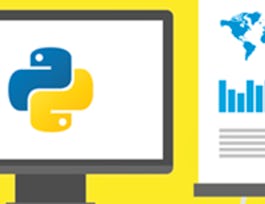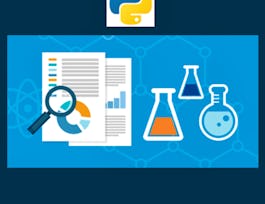Analyzing data with Python is an essential skill for Data Scientists and Data Analysts. This course will take you from the basics of data analysis with Python to building and evaluating data models.


Data Analysis with Python
This course is part of multiple programs.
Taught in English
Some content may not be translated

Instructor: Joseph Santarcangelo
427,313 already enrolled
Included with 
Course
(17,786 reviews)
94%
Recommended experience
What you'll learn
Develop Python code for cleaning and preparing data for analysis - including handling missing values, formatting, normalizing, and binning data
Perform exploratory data analysis and apply analytical techniques to real-word datasets using libraries such as Pandas, Numpy and Scipy
Manipulate data using dataframes, summarize data, understand data distribution, perform correlation and create data pipelines
Build and evaluate regression models using machine learning scikit-learn library and use them for prediction and decision making
Skills you'll gain
Details to know

Add to your LinkedIn profile
11 assignments
Course
(17,786 reviews)
94%
Recommended experience
See how employees at top companies are mastering in-demand skills

Build your subject-matter expertise
- Learn new concepts from industry experts
- Gain a foundational understanding of a subject or tool
- Develop job-relevant skills with hands-on projects
- Earn a shareable career certificate


Earn a career certificate
Add this credential to your LinkedIn profile, resume, or CV
Share it on social media and in your performance review

There are 6 modules in this course
In this module, you will learn how to understand data and learn about how to use the libraries in Python to help you import data from multiple sources. You will then learn how to perform some basic tasks to start exploring and analyzing the imported data set.
What's included
6 videos1 reading2 assignments2 app items2 plugins
In this module, you will learn how to perform some fundamental data wrangling tasks that, together, form the pre-processing phase of data analysis. These tasks include handling missing values in data, formatting data to standardize it and make it consistent, normalizing data, grouping data values into bins, and converting categorical variables into numerical quantitative variables.
What's included
6 videos1 reading2 assignments2 app items1 plugin
In this module, you will learn what is meant by exploratory data analysis, and you will learn how to perform computations on the data to calculate basic descriptive statistical information, such as mean, median, mode, and quartile values, and use that information to better understand the distribution of the data. You will learn about putting your data into groups to help you visualize the data better, you will learn how to use the Pearson correlation method to compare two continuous numerical variables, and you will learn how to use the Chi-square test to find the association between two categorical variables and how to interpret them.
What's included
5 videos1 reading2 assignments2 app items2 plugins
In this module, you will learn how to define the explanatory variable and the response variable and understand the differences between the simple linear regression and multiple linear regression models. You will learn how to evaluate a model using visualization and learn about polynomial regression and pipelines. You will also learn how to interpret and use the R-squared and the mean square error measures to perform in-sample evaluations to numerically evaluate our model. And lastly, you will learn about prediction and decision making when determining if our model is correct.
What's included
6 videos1 reading2 assignments2 app items1 plugin
In this module, you will learn about the importance of model evaluation and discuss different data model refinement techniques. You will learn about model selection and how to identify overfitting and underfitting in a predictive model. You will also learn about using Ridge Regression to regularize and reduce standard errors to prevent overfitting a regression model and how to use the Grid Search method to tune the hyperparameters of an estimator.
What's included
4 videos1 reading2 assignments2 app items2 plugins
Congratulations! You have now completed all the modules for this course. In this last module, you will complete the final assignment that will be graded by your peers. In this final assignment, you will assume the role of a Data Analyst working at a real estate investment trust organization who wants to start investing in residential real estate. You will be given a dataset containing detailed information about house prices in the region based on a number of property features, and it will be your job to analyze and predict the market price of houses given that information.
What's included
5 readings1 assignment1 peer review2 app items1 plugin
Instructor

Offered by
Recommended if you're interested in Data Analysis
Why people choose Coursera for their career




Learner reviews
Showing 3 of 17786
17,786 reviews
- 5 stars
75.97%
- 4 stars
18.62%
- 3 stars
3.69%
- 2 stars
0.93%
- 1 star
0.76%
New to Data Analysis? Start here.

Open new doors with Coursera Plus
Unlimited access to 7,000+ world-class courses, hands-on projects, and job-ready certificate programs - all included in your subscription
Advance your career with an online degree
Earn a degree from world-class universities - 100% online
Join over 3,400 global companies that choose Coursera for Business
Upskill your employees to excel in the digital economy
Frequently asked questions
Access to lectures and assignments depends on your type of enrollment. If you take a course in audit mode, you will be able to see most course materials for free. To access graded assignments and to earn a Certificate, you will need to purchase the Certificate experience, during or after your audit. If you don't see the audit option:
The course may not offer an audit option. You can try a Free Trial instead, or apply for Financial Aid.
The course may offer 'Full Course, No Certificate' instead. This option lets you see all course materials, submit required assessments, and get a final grade. This also means that you will not be able to purchase a Certificate experience.
When you enroll in the course, you get access to all of the courses in the Certificate, and you earn a certificate when you complete the work. Your electronic Certificate will be added to your Accomplishments page - from there, you can print your Certificate or add it to your LinkedIn profile. If you only want to read and view the course content, you can audit the course for free.
If you subscribed, you get a 7-day free trial during which you can cancel at no penalty. After that, we don’t give refunds, but you can cancel your subscription at any time. See our full refund policy.




